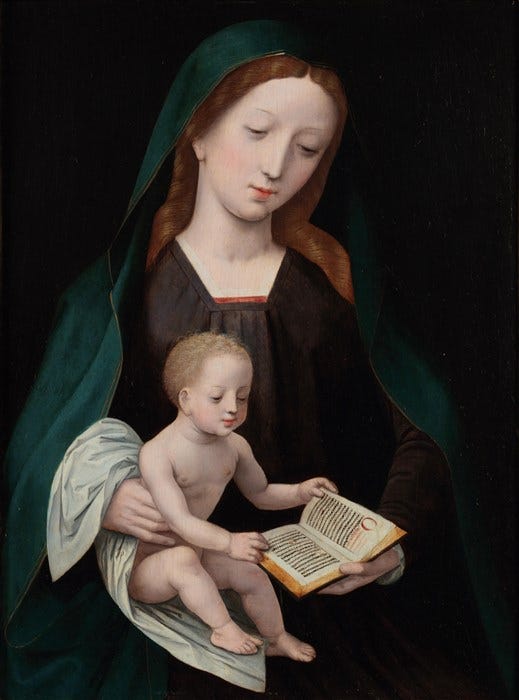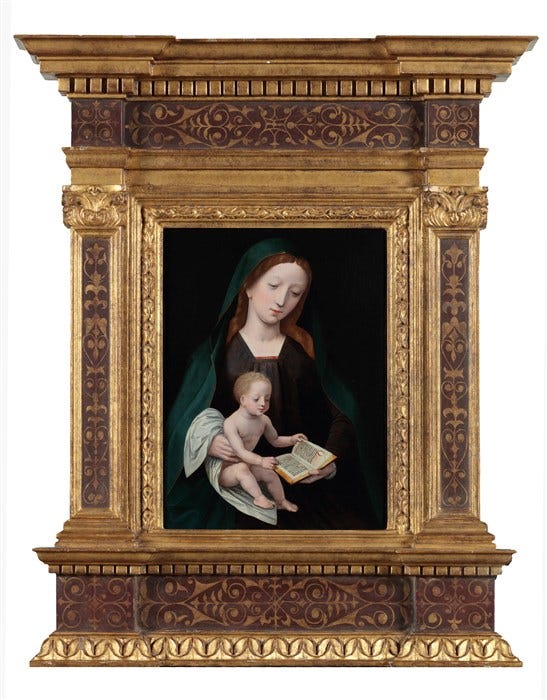The Book, The Word and the Logos
A commentary on a 16th century Dutch Painting from the House of Leiden collection
Artist: Anonymous, known as a follower of the Master of the Female Half-figures (active ca. 1520-1540); Oil on panel; 35.8 x 26.9 cm
I am reposting this for the benefit of the significant number of new subscribers who have joined since I first posted it and so haven’t read it. I will shortly repost my article about the cave paintings in the Lascaux in France. Thereafter, it will all be original material!
"In the beginning was the Word, and the Word was with God, and the Word was God. He was in the beginning with God; all things were made through him."¹
In this painting, the Mother of God tenderly looks down at her son lovingly as he playfully grasps a book. He is loosely clothed with white swaddling clothes as an allusion to his future death as one buried in a shroud. The artist has eliminated all superfluous background detail by shrouding it in darkness. This causes an intensified focus on the brightly lit figure of the baby Jesus, the face of Our Lady, and the book. The gaze of both Our Lady and of Christ are fixed on the book, so our attention rests there, too.
The book symbolises the "Word of God". While we might conclude that the book is the Bible, which is likely, it is important not to equate the reference to the Word of God and the Bible too narrowly. The concept of Christ as the ‘Logos’ or ‘Word’ of God derives from the Greek philosophical term λόγος (logos), which means both "word" and "reason" (the English word logic comes from this). Christ is the fullness of all that the scriptures speak of manifested in a person and is also an incarnation of Divine Wisdom and perfect reason - the Logos. So, in reality, we are directed to the book, but the book, in turn, directs us to the Divine person and not the other way around. In this sense, the Word might be considered an overflowing of the book's contents.
This painting might challenge many with a modern mindset in another way - by connecting Christ with reason. It is common today for people to believe that reason and faith are incompatible or at least unconnected. However, the message of the painting, consistent with the Faith, is that this is a mistake.
It is certainly possible to discover truths about God and the world through the unaided application of human reason. However, certain conditions must be met for our conclusions to reflect truth.
For example, our premises - the starting point in any line of reasoning - must be valid. Further, the data we process and interpret in the subsequent application of reason, usually obtained via the senses, must be accurate. Finally, the application of reason must be logical and not swayed by our desire to make the conclusions correspond to what we would like them to be.
In practice, these conditions are difficult to meet perfectly. Premises can be poorly chosen, information gained through the senses is often imperfect, and man's application of reason can be weak and easily misdirected by passions and imagination.
Precisely because reason—even in the seemingly most uncomplicated and most material matters, right before our eyes—can err and stubbornly cling to error, the New Testament constantly invites us to be aware of its limits and to trust in the words of the true Master, Jesus Christ. It’s worth noting that Christianity calls us to accept God’s word with faith and trust but also insists on applying reason with all our strength so that the premises and conclusions of faith can become wisdom—that is, the ability to understand that true meaning and happiness in life are found there. Faith that becomes wisdom does not detach us from rationality; rather, it enables us to see all things in a new light. C.S. Lewis expresses this beautifully: “I believe in Christianity as I believe that the sun has risen: not only because I see it, but because by it I see everything else.”2
Returning to the Bible, this is also why St. Paul repeatedly reminds us that while we must have faith in Christ, we are also called to contemplate and meditate on His life—from His preaching to His death on the cross—because in doing so, we can attain true wisdom:
“We are preaching a crucified Christ: to the Jews an obstacle they cannot get over, to the Gentiles foolishness, but to those who have been called, whether they are Jews or Greeks, a Christ who is both the power of God and the wisdom of God. God's folly is wiser than human wisdom, and God's weakness is stronger than human strength.”3
There can never be any contradiction between faith and reason (or faith and science, properly conducted), for all truth and order emanate from God. For a Christian, there should be no fear in asking questions or raising objections; wherever truth is found, the divine Logos will shine forth. The harmony and complementarity of faith and reason in the search for truth and wisdom were beautifully described by Pope St John Paul II :
“Faith and reason are like two wings on which the human spirit rises to the contemplation of truth; and God has placed in the human heart a desire to know the truth—in a word, to know Himself—so that, by knowing and loving God, men and women may also come to the fullness of truth.”4
Footnotes:
1. John 1:1-5.
2. C.S. Lewis, “They Asked For A Paper,” in Is Theology Poetry? (London: Geoffrey Bless, 1962), p165.
3. Cor 1:23-24
4. Pope John Paul II, Fides et Ratio, opening remarks, Saint Peter's Rome, (14 September 1998) <https://www.vatican.va/content/john-paul-ii/en/encyclicals/documents/hf_jp-ii_enc_14091998_fides-et-ratio.html>[accessed 26 November 2024].
Here is the painting in its fabulous frame:






You can't get a better host commentator than David Clayton!